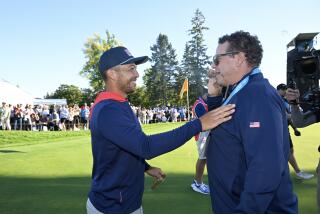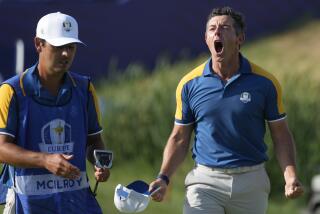Ryder Marks Anniversary of Format Change
- Share via
Twenty-five years ago this weekend, at a placid resort so hidden in the West Virginia hills that daylight is said to take 24 hours to reach it, the Ryder Cup was transformed from a biennial coronation of American golfing superiority to a fight-to-the-last-putt duel between continents.
Even if the few spectators or the participants had no idea what would soon become of an event that, at the time, was minimally contested and mostly ignored by the public and media.
This was no War on the Shore or Battle of Brookline -- the only fighting words at the 1979 Ryder Cup at The Greenbrier in White Sulphur Springs, W.Va., came from a Brit and a Scot upset at being shuttled off to a locale so distant for a team event that interested them so little.
Us vs. Them? Back then, the Ryder Cup was mostly Them vs. Them.
Jack Nicklaus changed all that, all without ever lifting a club.
A couple of years before -- coincidentally, at the same time he was redesigning the Greenbrier course for the 1979 Ryder Cup -- Nicklaus lobbied longtime British PGA president Lord John Darby to allow Europeans onto the Great Britain-Ireland team. The United States had won 10 straight Ryder Cups, and Nicklaus felt a change was urgently needed to preserve a traditional contest played since 1927 but endangered by its lack of competitiveness.
“We sat down in the lounge at the hotel in Lytham,” Nicklaus said. “I said, ‘John, the Ryder Cup is a very prestigious team to make. But, frankly, the American players really could care less about the matches because they walk away with them every year. It takes a week of their time and they are just going to win anyway.”
Rather than arguing for tradition or becoming upset at Nicklaus’ suggestion, Darby welcomed it.
“He said, ‘You leave it to me’ ... and he got that done,” Nicklaus said.
Did he ever. Now, the Ryder Cup is effectively the Olympics of golf, a must-watch event that stokes international passions. Since the change was made in 1979, the Americans have six wins, the Europeans five, with a tie in 1989 that let the Europeans keep the cup. But the United States has won only once since 1993, at Brookline in 1999, and only three of nine times since 1983.
“It grew and grew and grew,” said Bernhard Langer, a former Ryder Cup player and now the European captain.
Even if that growth wasn’t immediate and the format change, at least initially, was a whopping failure.
The only continental players added in 1979 were Spaniards Seve Ballesteros and Antonio Garrido, who were largely responsible for Europe’s 17-11 loss. They got off to an ominous start by losing Friday’s opening four-ball match 2 and 1 to Lanny Wadkins and Larry Nelson, a foretelling of what was to come during a weekend of play staged deep in the Allegheny Mountains.
They lost twice Saturday to Wadkins-Nelson, 3 and 2 in foursomes and 5 and 4 in fourball, then lost in singles the final day, Ballesteros 3 and 2 to Nelson and Garrido to Mark Hayes on the 19th hole. Nelson went 5-0 that weekend, still the only player to do so in Ryder Cup play.
Regardless, the Ryder Cup was much closer than usual, and not just because American star Tom Watson pulled out at the last minute to be with his pregnant wife, and Nicklaus, stuck in the worst year of his career, didn’t qualify.
The United States led only 8 1/2 -7 1/2 after two days, mostly because Europe won five of six Saturday matches not involving Ballesteros and Garrido. Europe also could have gained another half-point and perhaps some momentum on Sunday if team captain John Jacobs hadn’t made a generous gesture of sportsmanship that likely wouldn’t be extended today.
Jacobs and U.S. captain Billy Casper placed into an envelope the name of a player to be pulled if the opposing team had an injury. Casper, either by accident or by confusion, chose his best player, Lee Trevino, rather than his worst.
When Europe’s Mark James was scratched with an aching shoulder, Trevino should have rested, but Jacobs refused to benefit from Casper’s grievous error and allowed him to sit Gil Morgan instead. Trevino went on to beat Sandy Lyle 2 and 1.
Think Langer would give Hal Sutton a second choice at Oakland Hills next weekend should, say, Tiger Woods accidentally be scratched?
Of course, Jacobs was spending the weekend dealing with a simmering issue of his own. Unhappy possibly because of the inclusion of European players, James, who would be Europe’s captain 20 years later, and Ken Brown each missed a team meeting and posed uncomfortably for the team picture. Brown barely spoke to teammate Des Smyth during an embarrassingly bad 7 and 6 loss to Hale Irwin and Tom Kite in foursomes.
Upon returning home, both were heavily fined, and Brown, despite winning his singles match, was banned from the 1981 Ryder Cup.
The United States won again at Walton Heath in Surrey, England, in 1981, 18 1/2 -9 1/2 , but the momentum turned after that. The Americans won only 14 1/4 -13 1/2 at PGA National in Palm Beach Gardens in 1983, and Europe’s breakthrough victory came easily -- 16 1/2 -11 1/2 -- at the Belfry in Sutton Coldfield, England, in 1985.
By then, a niche event -- in 1979, ABC showed only a couple of hours’ coverage the entire weekend -- morphed into the premier international event in golf.
“Remember when whoever won the America’s Cup, the yacht race, it was, ‘Whoa, whoa, whoa, it’s the America’s Cup?”’ Haas said. “Who watched boat racing on TV until the Australians won? I think that’s what happened to the Ryder Cup. Until that (Europe won) happened, it was not as intense.”
More to Read
Go beyond the scoreboard
Get the latest on L.A.'s teams in the daily Sports Report newsletter.
You may occasionally receive promotional content from the Los Angeles Times.










